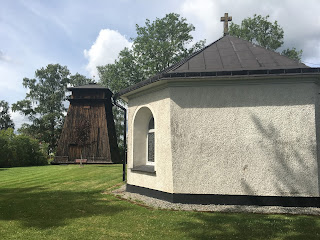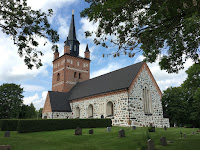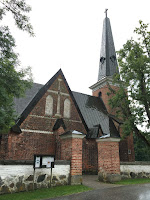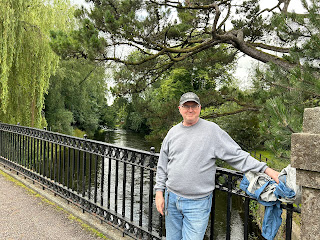Note: This is a continuation of a description of our trip to Sweden during July-August, 2016.
I think one of the common things that people do first when researching their family history is to see how far back in time they can trace their direct male line, following the family name. I was no exception, and here's a brief summary of what I've found to date, starting with my own father:
- Norman F. Johnson (1933-2001), born Ilion, New York, USA
- Fredrik A. Johnson aka Arthur Westerlund (1888-1937), born East Hempstead, New York, USA
- Gustaf Alfred Westerlund (1855-1923), born Teda, Uppsala, Sweden
- Johan Erik Westerlund (1825-1899), born Björksta, Västmanland, Sweden
- Johan Westerlund aka Johan Larsson (1794-1869), born Dingtuna, Västmanland, Sweden
- Lars Jansson (1769-1831), born Dingtuna, Västmanland, Sweden
- Johan Larsson (1738-1799), born Lillhärad, Västmanland, Sweden
- Lars Ericsson (????-????)
- Erik ???? (????-????)
The older generations, from Gustaf Alfred on back, all came from the area in and around the city of Västerås. This is one of the oldest cities in Sweden, having been occupied for a thousand years. It's located on the northern shore of Lake Mälaren, about 60 miles (100 km) west of the capital Stockholm in the province (län) of Västmanland. Its population in 2014 was approximately 144,000 people, so it's sizable, but not at all overwhelming. Since it is the focus of Westerlund family history, this (among other reasons) made it one of the prime places to visit on our trip.
The map above is a modern political map of the area, showing the names of the populated places in the area. If you're interested, I got this map from the Lantmäteriet site (www.lantmateriet.se), and with this link you can see the map and zoom in and out to get further details. The old church records, however, are arranged not by town (or kommun), but by parish. To help keep you oriented, the map below shows the boundaries of the parishes (församlingen) within Västmanland.
Västerås is a bustling city, and one of the major employers for more than a century is a multinational company called ABB. The modern company is the result of a merger between Asea AB of Sweden (founded in Västerås) and a Swiss company. According to its own advertising "the merged entity became the world's leading supplier in the $50 billion electric power industry." Its dominance as the employer in Västerås is commemorated in a sculpture found in the center of town. It's called ASEA-Strömmen, the ASEA stream, showing the workers commuting to work on their bikes with briefcases and lunchboxes in hand.
Behind the sculpture you can see the Statdshotellet, our base of operations while in the area.
Many relatives moved in and out of the city over the years, presumably following job opportunities. The center of the city is really dominated by the Västerås cathedral. Like most cathedrals, this one has constantly been expanded, repaired, and renovated through the years, but the oldest parts were first built in the 1200's.
From the city we made short excursions to visit the parishes whose names I've been seeing in the records. Let's start with the oldest records for the Westerlund lineage, the birthplace of Johan Larsson in 1738: Lillhärad. On the map below I've zoomed in a bit on the area just to the west of Västerås, and circled in red three of the parishes that I'll be mentioning.
Lillhärad is toward the top of the map. Like most of these parishes outside of the city, they're in the middle of active farmland: lots of grain fields, probably mostly wheat, along with smaller livestock operations. The small church of Lillhärad is fairly recent and was built long after the birth of Johan Larsson. It currently still hosts baptisms, weddings, and funerals, but for regular services it's rented out to the local Russian Orthodox congregation. Note the separate wooden building housing the bell tower.
The next two generations of Westerlunds (or, Westerlunds-to-be) were born in Dingtuna. This is the southernmost parish circled in red on the map. The parish dates from the Middle Ages and, originally, served as the "mother parish" for the church in Lillhärad. Today they're linked again. The present church is the result of extensive renovations undertaken in 1842. Johan Larsson moved to Dingtuna as a teenager in 1758 and remained until his death on 18 Jul 1799. His son Lars and Lars's son, also named Johan, were born here. The church was closed, so we didn't get a chance to get inside. There is a small graveyard adjacent to the church, and a larger, newer one across the road. The wall separating that newer cemetery from the road is built from pieces of old gravestones. I'm sure there's an interesting story there, certainly with histories extending back to the 1200s, there's just not enough physical space to do everything. But my historian instincts quiver at the thought of the loss.
From here we move to the area to the east of the city of Västerås. Here's the map with the parishes to be mentioned circled in red.
I'll start at the top with Björksta. Johan Erik Westerlund was born in Björksta on June 9, 1825. His first wife was Johanna Larsson (1820-1871) with whom he had two sons, Gustaf Alfred and Gottfrid Theodor. After Johanna died, he married Carolina Jansdotter (1824-1900). Johan Erik lived and worked in numerous parishes in the vicinity. Eventually in 1898 the couple moved about 35 miles south to Åker in the province of Södermanland where they lived out their lives.
The Björksta parish church is quite old, the earliest part dating from the 1200s. The picture clearly shows that the bell tower was a later addition to the building, dating from the 1400s. The bowl of the baptismal font dates from 1529, so it is very likely the one where Johan Erik was baptized. The church is situated in the midst of flat farmland interspersed with hills. While the church sounds - and is - very old, a thousand years ago all of the flat area was underwater as Lake Mälaren reached much farther than it does now. There is evidence of even older residents of the area in the form of rock carvings. There are quite a number of these in the general area, including some right next to the church. These carvings date from the Bronze Age, from 1800 to 500 B.C., in other words, these carvings are at least over 2500 years old! The carving on the left in the picture is supposed to be a stylized chariot, and the other elongate carvings are ships.
From Björksta we continued south to Ängsö. At the time I knew very little about this area: I'd heard that there was a castle there, and as we were driving around the countryside we saw a sign pointing us to Ängsö and decided on a whim to check it out. I've later discovered that lots of the family came from the island. Johan Erik Westerlund's first wife, you recall, was Johanna Larsson. Johanna was born in Teda, a parish to which I'll get shortly. Here's her direct ancestral line as I now understand it:
- Johanna Larsson (1820-1871), born Teda, Uppsala
- Lars Andersson (1760-1829), born Ängsö, Västmanland
- Anders Ersson (1723-1762), born Ängsö, Västmanland
- Erik Mattsson (1700-1748), born Ängsö, Västmanland
- Mats Mattsson (1675-1719), born Ängsö, Västmanland
So there are lots of relatives from Ängsö. Of course, the wives of these generations were also born there as well. I hadn't yet worked all this out when we visited. Inside the church at Ängsö we were greeted by a local volunteer who described the history of the church, again it's amazing old, dating to the 1340s. The volunteer, Tom, also filled us in on the local ghost stories. Just for fun, there's a YouTube video that plays up these stories for Halloween. I liked it because these were exactly the roads and walks we took when we explored the area. In the video the blocky, square building is the castle, and it's located right next to the church across a small courtyard.
I hope that was fun! Here are some of our pictures. Sorry, I didn't record any no ghosts or skeletons.
As you can see, I've organized our visits to parishes by following the history of the Westerlunds, beginning from the earliest records and moving forward in time. That leaves us with the last generation, Gustaf Alfred Westerlund. He was the last of my direct ancestors in the Westerlund line who was born in Sweden. He was born in Teda on March 9, 1855. Our visit to Teda, though, was special because it was organized by my third cousin, Hans Malmkvist. Hans's great grandfather was Gottfrid Westerlund, brother of my great grandfather Alfred. Teda is a tiny farm community found just over the provincial border in Uppsala. Our visit there was special for two reasons. First, we were accompanied not only by Hans and his wife Kristina, but by Hans's brother, Gunnar, and his sister Birgitta and her husband Torbjörn Engkvist. Second, Hans arranged a visit to the actual house where the Westerlund family lived and where his great grandfather Gottfrid was born in 1863. The house, called Leversta, is very small, really with only two usable rooms. The current owner uses it primarily as a vacation home.
Our trip to the home at Leversta was not the end of the day, though. We visited Anundshög, a Viking burial mound site. In addition to the mound, there are two large stone ships and a large runestone on the site. Estimates of its age are imprecise, but we're talking about the Iron Age (500 BC - 1050 AD). From there we went to the Vallby Open Air Museum (Vallby Friluftsmuseum), a living historical museum with old buildings from around Västmanland illustrating the ways of life of Swedes in the region. To cap off the day, Hans and Kristina invited us to their home for dinner. They told us that the meal was similar to a Midsummer Day's meal, with such delicacies as freshly made pickled herring, baked salmon, new potatoes fresh from Hans's garden, and a wonderful dish called Janssons Frestelse, or Jansson's Temptation. Just who Jansson was is a matter of some dispute, but the dish is wonderful: think scalloped potatoes with anchovies or sprats instead of ham. I tried making it when I got back home from a recipe on the Internet, and, while it was really good, believe it or not I think I needed even more anchovies! Now I've learned that perhaps anchovies are the wrong sort of canned fish, and what I really need to try are sprats. I'm game!
At dinner we got the chance to meet Hans and Kristina's daughter Lotta Werneholm and her husband Claes. Lotta carries on the family tradition of working for ABB, following in her father's footsteps. Gunnar told us that his son, Daniel, is living and working in Manhattan: I need to find the Swedish coffee shop Fika where he works. The name Fika refers to the honored Swedish tradition of a coffee break, classically taken with cinnamon rolls or similar pastry. Hans broke out some of the old family photo albums to show us and gave me a chance to put some faces to the names I'd seen in the old written records. In sum, it was a fantastic welcome, and I couldn't be more thankful for the friendliness and hospitality!
While the Westerlund family history begins and is concentrated in the area around Västerås, here we also first crossed paths with the other half of my Swedish family, the extended relatives of Johanna Charlotta Barthelson, the wife of Gustaf Alfred and my great grandmother. The Barthelson story, for me, is focused in the province of Värmland, and I'll be concentrating on our visit there in the next blog post. But through the magic of the Internet and a shared interest in family history, in Västerås we also had the great pleasure of meeting another cousin from that Barthelson side: let me introduce you to Sven and Eva Backlund.
Eva and I are third cousins once removed. To try to translate that into something more understandable, that means that Eva's great grandfather, Per Barthelson (1814-1858), was my great great grandfather. So for me it's 5 generations to get back to Per, for her it's only four generations. Eva has quite a number of family treasures, and she's been tremendously generous in sharing them with me. For example, here are some photos from the past, starting with the most recent generations:
Sven and Eva took us to the parish church of Svedvi, located a bit west of Västerås near the town of Halstahammar. Svedvi is the parish in which my great grandmother, Lotta Barthelson, was born in 1861. The church here dates to the 1200s, and next to it is a large, flat, gray stone which the notes on the church's history say was a blood altar from the pre-Christian, heathen times!
From the church, we then visited the Strömsholm canal in Halstahammar. The 62-mile long canal was originally used as a means of transport of iron from the steelworks to the north south to Lake Mälaren (and from there to anywhere in the world). Now it's a very pleasant park and outdoor museum. In one of the main office buildings of the old canal administration there is a line of photos showing the administrators and engineers in charge of running the canal. When Eva saw the name of Daniel Stafsing, the canal CEO in the early 1900s, she reached into her bag and produced work testimonial dated 26 June 1907, written by Stafsin commending her grandfather, Karl Gustafsson.
After our field trip, Eva and Sven invited us to their home for dinner. We were treated to Aperol Spritzes and delicious curried salmon. To cap off another great day, they broke out their family heirloom treasures, including old photographs and even a pair of small shoes made by hand by one of Eva's family. I have to ruefully I admit that I don't remember the details about the shoes. Eva, if you're reading this post, please add a comment to remind me of the story!
So wraps up a brief summary of our visit to Västerås. The weather was wonderful, the people even better, and lots to see and learn. And I haven't even touched on our other day trips in the area. There's no way that I can adequately express my thanks and gratitude to all of those who so warmly greeted and shared a bit of their lives with us. Tack så mycket! From Västerås, we next drive about four hours west to really get into the Barthelson experience in Värmland.




















































No comments:
Post a Comment